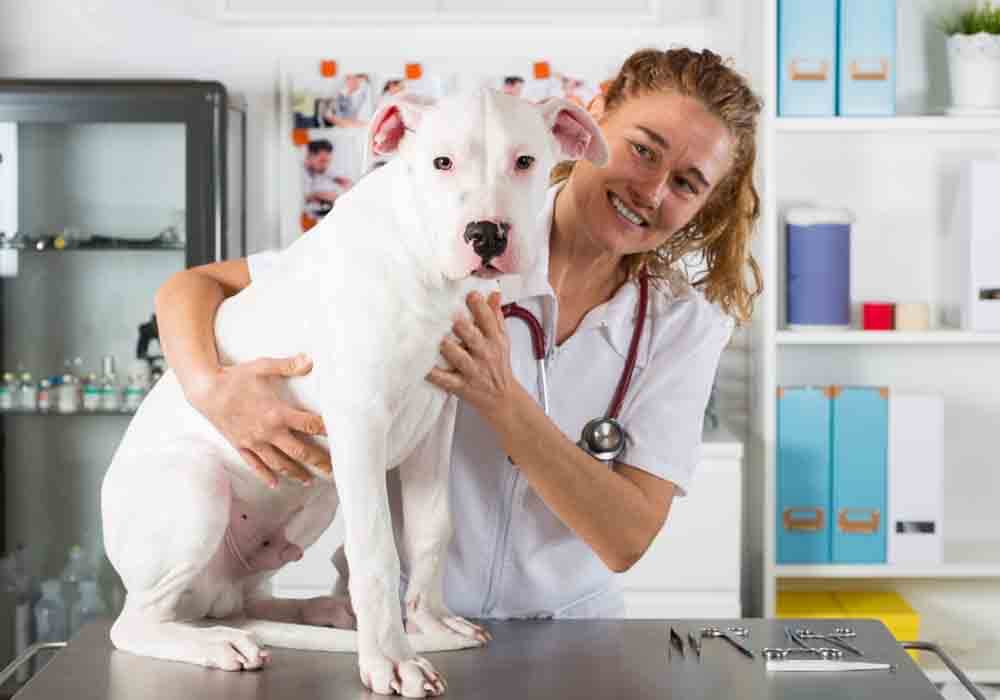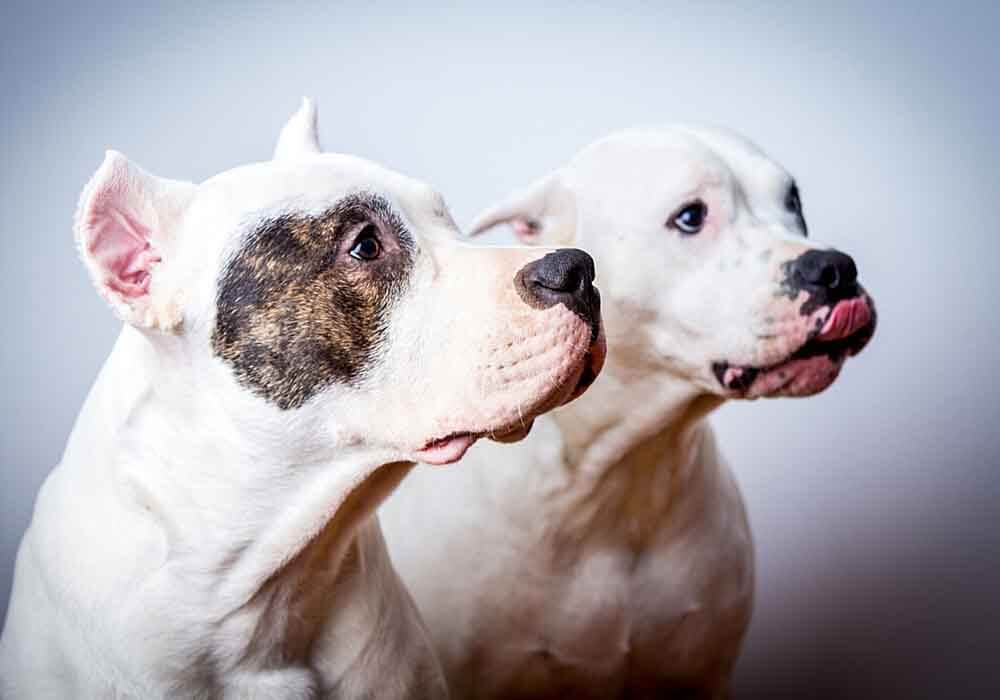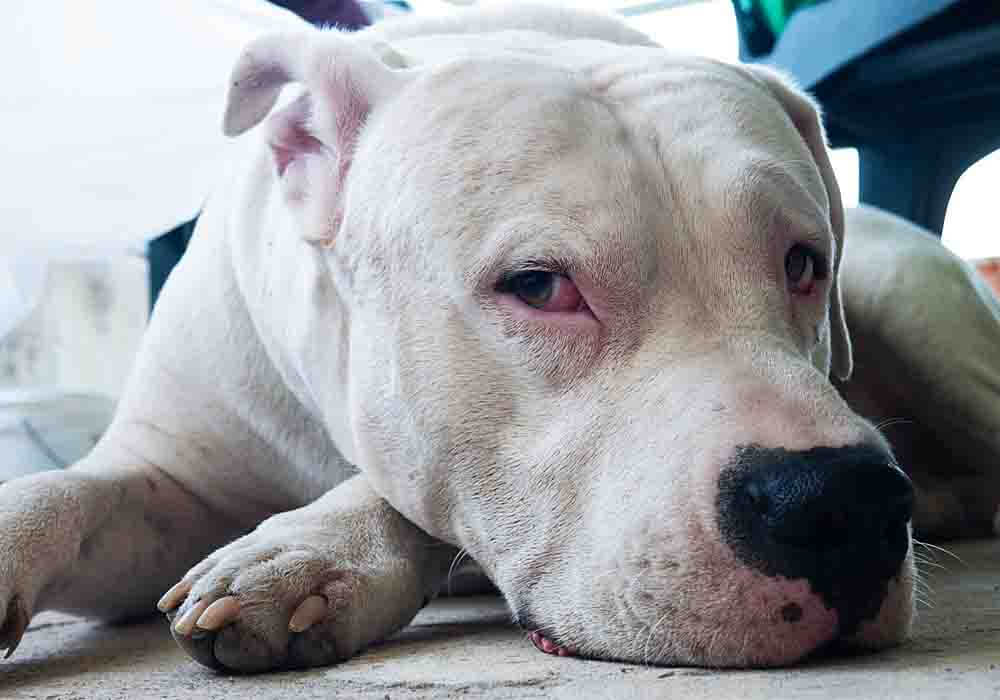Dogo Argentino Health Issues
Descriptions, Symptoms and Treatments
The
Dogo Argentino is a beautiful and loyal breed, but they're not without their
health challenges. From bloat and hip dysplasia to allergies and cancer, it's
important for owners to be aware of the health issues that can plague this
majestic breed.
Let's take a closer look at the common ailments that affect the Dogo Argentino, so you can keep your four-legged friend in tip-top shape.
Dogo Argentino Health Issues...Key Takeaways
• Bloat is a serious and potentially life-threatening condition in Dogo Argentinos, characterized by a distended abdomen and other symptoms. Seek immediate veterinary care if bloat is suspected.
• Hip dysplasia is a common health issue in Dogo Argentinos, causing lameness and decreased range of motion. Treatment options range from medication to surgery, and lifestyle changes can be beneficial.
• Cherry eye is a condition that can affect Dogo Argentinos, causing swelling and discomfort in the eye. Prompt veterinary care is necessary, and surgical removal or repositioning of the affected gland is typically required.
• Dogo
Argentinos can develop various types of cancer, but they have a lower risk
compared to other breeds. Early detection and treatment are crucial, and
regular checkups and screenings at the vet are important for monitoring their
health.
by Ken Alden
Disclaimer: The writers of this page are not veterinarians. The information we provide should not be a substitute for veterinary medical advice. Pet owners should always consult with their vet if they have any pet-related questions or concerns.
Pro-tip: Ever try lifting a Dogo Argentino? Their weight can hurt not only your back but their joints when they hop down from cars, sofas or even your bed. To protect your back and theirs check out the best Mastiff ramps on Amazon.com now.

Bloat In Dogo Argentinos
You may be familiar with the Dogo Argentino, a large and powerful breed of dog. Unfortunately, they also have to deal with serious health issues, such as bloat.
Bloat is a condition where the stomach fills up with gas and can twist on itself, leading to pain, shock, and even death if not treated quickly. Symptoms of bloat in Dogos include restlessness or pacing, excessive drooling or salivation, distended abdomen, rapid shallow breathing, and pale gums.
Treatment
for bloat involves relieving pressure on the stomach by draining gas or fluids
from it as well as administering medications and monitoring fluid levels. It is
important to act fast when dealing with bloat in a Dogo Argentino so that their
life can be saved!
Dogo Argentino Bloat Symptoms
If you notice any of the following symptoms, it could indicate bloat in your Dogo Argentino: abdominal swelling, restlessness, pacing, drooling, and labored breathing.
If you've noticed any of these signs or symptoms in your Dogo Argentino it is important to seek veterinary care right away to confirm your suspicions and begin treatment.
Next,
we will discuss how bloat is treated in Dogo Argentinos.
How Bloat Is Treated in Dog Argentinos
Treating bloat in Dogo Argentinos depends on the severity of the condition and may include medications, surgery, or a combination of both.
Medications such as anti-gas medications and anti-inflammatories can help reduce discomfort and bloating caused by the condition.
In more serious cases, surgery may be necessary to correct any underlying issues that are causing the bloat. Surgery is often used to remove any gas build up or blockages in the stomach or intestines that could be contributing to the problem.
In some cases, a combination of medications and surgery may be recommended depending on how severe the bloat has become.
It's
important for owners to seek prompt medical attention if their Dogo Argentino
starts showing symptoms of bloat so that proper treatment can be provided
quickly.

Learn even more about Bloat and just how dangerous it can be in this article of ours which covers it in depth.
Pro-tip: Dogo Argentino anxiety, aggression, destructive chewing, jumping up, fearfulness, and other behaviors can be controlled with the right training program.
Here’s a great course that
addresses these issues along with many other dog training basics: Check it out now!
Dogo Argentino Hip Dysplasia
Hip dysplasia is a common health issue in Dogo Argentinos. Symptoms may include limping, difficulty standing or climbing stairs, and arthritis.
Treatment for hip dysplasia can range from anti-inflammatory medications to surgery.
With
the right care, your pooch can live a long and healthy life despite
this Dogo Argentino health issues.
Hip Dysplasia Symptoms in Dogo Argentinos
Signs of hip dysplasia in Dogo Argentinos include:
• Lameness
• Stiffness
• Decreased
range of motion
• Difficulty
rising or jumping
You may notice your pup limping on one or both hind legs, having trouble climbing stairs or getting up from a resting position. Additionally, you can observe an uneven gait and reduced activity levels in general.
Numerically speaking, the signs are:
1. Lameness
2. Stiffness
3. Reduced Range of
Motion
It's important to note that these symptoms may not be immediately obvious; they may develop over time as the condition progresses. Early diagnosis is key for managing the condition effectively with non-invasive measures such as exercise and weight control. If untreated, hip dysplasia can cause pain and arthritis later on.
Be
sure to consult with your vet if any signs are present so you can provide your
beloved Dogo Argentino with the best care possible!
How Hip Dysplasia Is Treated in Dogo Argentinos
Managing hip dysplasia in Dogo Argentinos typically involves a combination of lifestyle changes and medical treatments. Your veterinarian will likely recommend increasing exercise with low-impact activities to help prevent further damage to the joint. Swimming is an excellent choice as it provides resistance without stress on the hips.
A diet change may also be necessary to keep your Dogo Argentino at a healthy weight, as this can take some of the strain off their hips. In more severe cases, surgery may be required. This could involve reconstructing or replacing damaged joints or fusing them together so they don't move around causing pain and discomfort.
As
always, it's important that you follow your vet's instructions for treating
your pup's hip dysplasia and make any necessary lifestyle changes to ensure
their long-term health and well-being.

Want to learn about Hip Dysplatia in greater depth? This health issue is very common in larger dogs (regardless of breed) and deserves a further read in this article on our site.
Dogo Argentino And Cherry Eye
If you have a Dogo Argentino, you should be aware of the symptoms associated with Cherry Eye and how it can be treated.
This disorder is characterized by swelling of the third eyelid, resulting in a mass that looks like a cherry in the corner of your dog's eye. Common signs include redness, pain, tearing, discharge from the affected eye, and an inability to close the eyelid completely. dogo argentino health issues
Treatment
usually involves surgically removing or repositioning the affected gland. In
more severe cases, antibiotics may be prescribed to help reduce swelling and
prevent infection.
Cherry Eye Symptoms in Dogo Argentinos
Dogo Argentinos are prone to developing cherry eye, a condition characterized by the prolapse of the third eyelid gland. Symptoms include swelling and redness around the eye, discharge from the affected eye, and visible bulging of the third eyelid.
It is important to seek veterinary care for cherry eye as soon as possible, as it can lead to more serious problems if left untreated. Symptoms may worsen over time and cause discomfort and pain for your pup. To prevent further damage, prompt action should be taken once you notice any of these symptoms in your Dogo Argentino.
Moving
on, let's discuss how this condition is treated in Dogo Argentinos.
How Cherry Eye Is Treated in Dogo Argentinos
After discussing the symptoms of cherry eye in Dogo Argentinos, let's now look at how this condition is treated.
Treatment for cherry eye typically involves surgically replacing the prolapsed gland back into its normal position. This type of surgery is usually done under general anesthesia and can be performed by a veterinarian or an ophthalmologist.
After
surgery, antibiotic drops may be needed to prevent infection and
anti-inflammatory medication may also need to be given. In some cases, your vet
may suggest leaving the prolapsed gland untreated as long as it doesn't
interfere with sight. However, this isn't always recommended due to potential
complications such as dry eye and infection in the future. dogo argentino health issues
Pro-tip: Dogo's (and their owners) love dog crates…and for good reasons. Crates keep dogs from mischief while you're away, are perfect for house training, for traveling by car, and provide the dog a place to de-stress. Check out the best Mastiff crates on Amazon.com now.
Cancer in Dogo Argentinos
You may be surprised to learn that Dogo Argentinos can suffer from cancer, just like any other dog breed. There are various types of cancers they can develop, ranging from lymphoma to mast cell tumors.
However,
it is important to note that the Dogo Argentino has a lower risk of developing
these types of illnesses compared to other dog breeds. Knowing the signs though
and symptoms of cancer in this breed is key to providing them with proper care
and treatment if needed.
Various Types of Cancers In Dogo Argentinos
These cancers include lymphoma, mast cell tumors, and melanomas. Other cancers, such as hemangiosarcoma and osteosarcoma, are less common. It is important to recognize the signs of cancer early on to provide the best possible care for your Dogo Argentino.
Regular checkups and screenings at the vet are crucial to catch any potential issues before they become serious or life-threatening. With prompt diagnosis and treatment, many Dogo Argentinos can live full lives despite their health issues. Therefore, it's important to be aware of all the possible types of cancer in order to watch for any warning signs and take proper action quickly if necessary.
Here's
another issue this breed experiences difficulties with and they are…
Dogo Argentino Allergies
Unfortunately, Dogo Argentinos can suffer from allergies to certain foods and environmental factors. Allergies in this breed of dog are typically caused by an overactive immune system that reacts to what it perceives as a threat. Common allergens for Dogo Argentinos include dust mites, pollen, mold spores, and pet dander. Food allergies can also be present and may be triggered by beef, dairy products, wheat, or corn. dogo argentino health issues
The signs of an allergy can range from mild itching and skin irritation to severe inflammation with hair loss if left untreated. The most common symptom is excessive scratching which could lead to hot spots or open wounds on the skin that become infected. In addition to these physical symptoms, dogs may also experience digestive issues like vomiting and diarrhea as well as respiratory problems such as sneezing or wheezing due to inhaling allergens in the air.
If your Dogo Argentino is exhibiting any of these symptoms you should consult with your vet immediately for proper diagnosis and treatment plan. Treatment for Dogo Argentino allergies typically involves avoiding exposure to the allergen whenever possible while also managing the symptoms through anti-inflammatory medications or other therapies such as immunotherapy shots or special hypoallergenic diets depending on the severity of the condition.
It
is important that owners take any allergic reactions seriously so they can
provide their pet with the best care possible and help them live a happy life!
Dogo Argentino Health Issues…Conclusion
At the end of the day, it's important to remember that while Dogo Argentinos can suffer from health issues, they are still loving and loyal companions.
With regular vet visits and proper care, you can ensure your pup has a long and happy life.
As the old saying goes: 'An ounce of prevention is worth a pound of cure.'
So
don't wait until something is wrong; be proactive about your pet's health and
you will have many years of joy with your furry friend.
Return to the top of this Dogo Argentino Health Issues page

About the Author...
Ken Alden, a dedicated Mastiff owner for over eight years, is acclaimed for his expertise in care, grooming, and training. Read more About Me and my dog Shadow.
- Mastiff Guide Home ›
- Mastiff Breeds Info ›
- Dogo Argentino Health Issues



